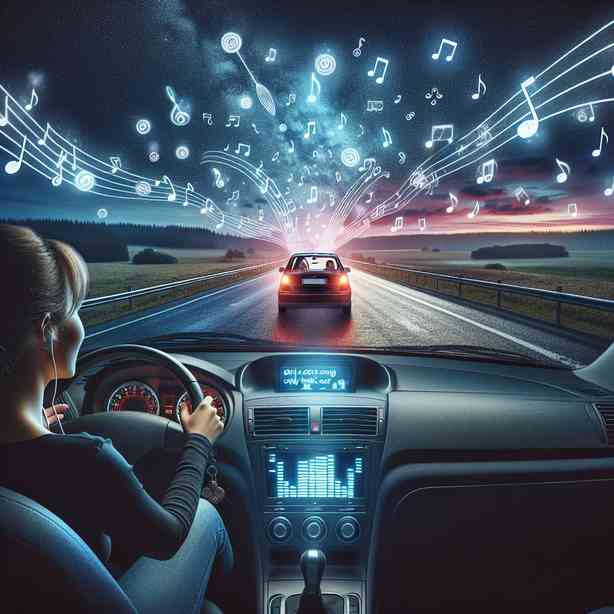
Some songs evoke a unique kind of magic when played in the car. The experience of driving, the rhythm of the wheels on the asphalt, and the open road seem to enhance certain tracks in a way that simply listening to them at home or in a different setting doesn’t quite achieve. It invites us to explore why certain songs resonate powerfully during drives, creating a special atmosphere and feelings.
The first element that often contributes to the car listening experience is the feeling of freedom associated with driving. When we are behind the wheel, there’s a sense of control and adventure, the open road ahead leading us into the unknown. That liberation allows us to embrace songs in a way that feels almost transcendental. Genres like rock, pop, or even electronic music tend to have a beat and vibe that match the heartbeat of the journey; it’s as if the music itself is meant to accompany us in our travels. Many drivers find that songs with driving beats and catchy hooks can turn mundane commutes into exhilarating experiences.
Another essential factor is the acoustics of a car. A vehicle can create a unique auditory environment, enclosed yet dynamic, where sounds may resonate differently compared to a room or outdoor setting. The engine’s hum can actually enhance music during playback, creating a rich soundscape that envelops the listener. Songs tailored with powerful basslines or intricate instrumentation often find a perfect home in this setting. Elements that might seem subtle when heard through home speakers can become pronounced in a car, leading us to discover new layers and dimensions in familiar tracks.
Apart from the technical aspects, the emotional connection we have to music played in cars can significantly impact our involvement with a song. A drive can become intertwined with memories, whether it’s a road trip with friends, a solo journey for reflection, or trips to significant events. Many people can trace milestones in their lives marked by specific songs they played while driving. This association solidifies a song’s meaning and purpose, making it almost a soundtrack to one’s life. Therefore, when those songs come on in the car, they can evoke nostalgia, excitement, or even longing, heightening our emotional responses.
Moreover, the context of being in a car also provides an immersive experience. When listeners are behind the wheel, they are less likely to be distracted by responsibilities or chores at home. The road ahead, the scenery passing by, and the sense of movement create an atmosphere where one can fully engage with the music. This focus enables listeners to appreciate lyrics or melodies they might overlook in different environments.
Songs featuring themes of escape, adventure, or the journey of life often resonate strongly during drives. Lyrics that focus on freedom, love, or individuality can amplify feelings via the backdrop of open vistas and changing landscapes outside the window. Such themes turn every journey—no matter how mundane—into a personal narrative filled with meaning and emotional weight.
At this juncture, we can also contemplate how certain genres align more naturally with driving experiences. Upbeat tracks with driving rhythms, such as electronic dance music (EDM) or classic rock, work effectively as they provide an energetic backdrop that instills a sense of movement. Additionally, certain songs with powerful hooks can transform a car ride into a sing-along session, where passengers become participants rather than mere listeners. This participative aspect further enhances the enjoyment of the experience, making it more memorable.
For those who appreciate storytelling in music, the car setting allows for a unique way to delve into narratives expressed in songs. As the scenery whizzes by, songs that unfold stories can create vivid mental imagery, allowing us to visualize the plot or the emotions conveyed. It’s like watching a movie unfold outside as the soundtrack plays in perfect synchrony. The context acts as an enhancement to the artist’s intention, enriching the experience of the song itself.
In contrast, the same songs might not resonate as strongly in other environments. When we listen to music at home, distractions can arise, such as chores, the television, or even phones buzzing with notifications. The home atmosphere may also lack the intentional focus that driving provides, which can lead to a diminished appreciation for the nuances of certain tracks. This indicates that specific contexts can limit or enhance our engagement with music, further deepening our connection to songs that work best in the car.
Moreover, the act of driving itself can create a state of mind that primes us to absorb music differently. The rhythmic motion, coupled with a sense of autonomy, can inspire introspection or evoke creativity that might not strike while sitting still. Some people report that driving gives them a clearer headspace, allowing lyrics or melodies to resonate more deeply than when they are stationary.
In essence, the reasons behind why some songs only seem to work in the car cultivate a unique interplay among emotional connections, auditory feedback, and the transportation medium itself. The immersive nature of car travel combined with our ability to reflect on personal narratives while driving creates a symbiotic relationship with the music. This not only elevates our experiences but also helps build lasting memories tied to each song.
As we wrap up this exploration, it becomes clear that the magic of songs that resonate particularly in cars largely hinges on a multidimensional interaction amongst the song itself, the driving experience, and the emotions we bring to that experience. It’s a phenomenon where speed meets sound, feelings flow, and memories are made—transforming a simple car ride into an extraordinary experience filled with emotional significance and lively connectivity. Next time you hit the road, take a moment to appreciate the songs that elevate your journey—they may just be the soundtrack to a beautiful moment waiting to happen.


